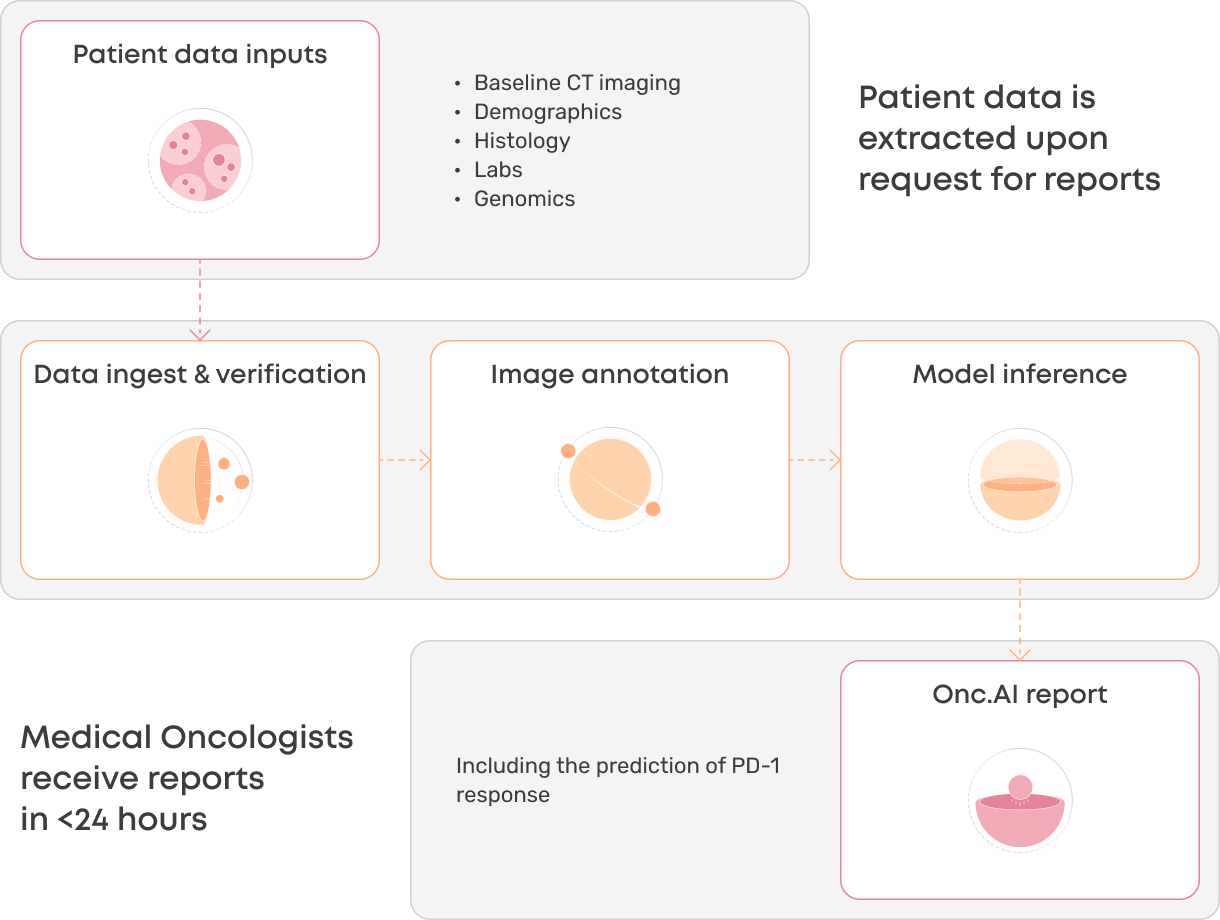Precision Oncology Software Development with Advanced Medical Imaging and Multi-omics
Onc.AI is at the forefront of integrating advanced medical imaging, radiomics, and multi-omic data to enhance treatment precision in oncology. Its mission is centered on utilizing the power of ML to refine treatment decisions for cancer patients, with a special emphasis on the use of PD-(L)1 immunotherapy, which has transformed cancer treatment.

Leveraging advanced radiomics and ML techniques, Onc.AI identifies biomarkers crucial for predicting responses to PD-(L)1 inhibitors without the invasive tissue or liquid biopsy. This empowers oncologists to make informed, life-saving treatment decisions.
Onc.AI develops sophisticated clinical management tools specifically designed for oncologists, facilitating a more nuanced approach to patient care and advancing the field of oncology at large. In addition, Onc.AI collaborates with leading pharmaceutical research entities, enhancing patient selection and decision making in clinical trials to ensure the most effective therapeutic strategies are identified and employed.
In summary, Onc.AI leverages the Valohai MLOps platform to eliminate all roadblocks from its path:
- Isolating and versioning experiments with everything traceable to its origin: from data to parameters, metrics, and even relation to specific medical studies and patient cohorts.
- Scheduling hyperparameter tuning jobs for exploring model architectures and feature selection parameters.
- Managing infrastructure resources across all major cloud providers as well as on-premise hardware.
- Automating dynamic validation pipelines during pre-clinical evaluation.
Predicting and Monitoring Treatment Response
There is an underlying biology that drives the appearance of tumors in diagnostic medical imaging (such as CT, MRI, and PET) sometimes referred to as the radiographic tumor phenotype. But without the aid of cutting-edge ML models, radiologists and oncologists face natural limitations in identifying these phenotypes.

There's an understanding within the radiology and oncology communities that tumor appearance on diagnostic imaging is closely related to the underlying biological processes and ultimately the tumor's aggressiveness and likelihood of responding to specific therapies.Deep Learning is the perfect tool to actually get to the bottom of this with enough data to build predictive models and to pull out important scientific and clinical insights.
Petr Jordan – CTO, Onc.AIOnc.AI leverages its multimodal modeling approach to predict and monitor the response to immune checkpoint inhibitors and improve immunotherapy treatment outcomes. Medical oncologists can request patient reports through the Onc.AI applications, which are deployed to clinics via a software cloud platform.
 How Onc.AI serves predictions to medical oncologists via its applications.
How Onc.AI serves predictions to medical oncologists via its applications.Over the last decade, immune checkpoint inhibitors (ICIs) have revolutionized cancer care. However, these therapies are extremely expensive and work in only about 30% of cases. Therefore, there is an urgent need to identify patients likely to benefit from ICI treatment. There are only two FDA-approved biomarkers to predict response to ICIs, neither of which are accurate enough for clinical decision-making. Fortunately, radiomics is a promising solution with initial research studies indicating high predictive accuracy.
Onc.AI identifies patients who do well on the immune inhibitors by extracting computational biomarkers from CT scans, which are non-invasive and acquired as standard-of-care in all clinical settings. Onc.AI further supplements these findings with other multi-omic data, such as additional imaging, and molecular and demographic data.
As a result, Onc.AI is able to monitor the effectiveness of immunotherapy and enable medical oncologists to make timely and life-saving decisions around optimal treatment administration and whether to continue or change the treatment for their patients. The predictions are available on the same day, further enhancing the need for state-of-the-art MLOps.
Why Valohai?
With Valohai, Onc.AI can automate its ML pipelines while bringing together data from diverse sources and integrating open-source tools in one MLOps platform no matter the environment.
 How Onc.AI defines its ML pipelines.
How Onc.AI defines its ML pipelines.Smart Orchestration
Valohai takes the burden of orchestration away from data scientists and ML engineers, enabling them to focus on their core work: pushing the boundaries of medical imaging by building new and improving existing ML models.
In Valohai, all users can define a computational task and package it to the platform. Next, Valohai takes care of running all the relevant tasks (experimentation, data preparation, validation, and pipeline orchestration) in suitable environments.
This means that everyone at Onc.AI can compute in different environments (major cloud or local hardware) without having to change the code in any way while running it in a controlled and organized way.

Large healthcare systems tend to run on Azure. For our own development, we prefer GCP.
We don’t have to think too much about committing to one cloud provider. We can develop everything within the multi-cloud setup under Valohai with minimal changes to our code.
For different GPU workloads, Onc.AI leverages Valohai to choose between different cloud providers (AWS, Azure, and GCP) based on their availability.
Knowledge Repository
Valohai automatically tracks all assets and organizes them under relevant projects: from versioning code and data to collecting logs and artifacts, and reporting on the latter.
As medical device manufacturers must comply with regulations, they are required to provide a detailed account of how their models arrived at the conclusions while showing all aspects of the development such as training parameters, source code, and data sets.

If you can manage to move all of your product development under the MLOps platform,all of those questions become traceable. And you essentially have a complete audit trail from model prediction all the way back to your data source.
Petr Jordan – CTO, Onc.AIWith the help of Valohai, the Onc.AI team can isolate every experiment and trace back to what exact data, code, and parameters were used to generate the results. In addition, the team uses Valohai Aliases to keep track of the latest models related to relevant studies.
Developer Core
Valohai comes with developer-friendly integrations to Git and Docker. The API-first approach of the Valohai MLOps platform equips Onc.AI with seamless integrations and robust automation. Here’s exactly how they leverage Valohai’s Developer Core:
Pipelines
The Onc.AI team integrates pipelines to all existing systems through API. In addition, all pipelines are automatically versioned in YAML files on Git, which the team uses actively.
The team utilizes the Valohai Triggers to schedule pipelines on a weekly or even daily basis. In addition, the team also utilizes Dynamic Pipelines that run daily to generate new datasets. Depending on the volume of data from new studies and patient cohorts, the Valohai MLOps platform scales these pipelines dynamically.
Integrations
Streamlined workflow integrations enable all steps to seamlessly work together regardless of who wrote the code. Moreover, running bash commands allows the team to customize their jobs to run more complex steps beyond single Python scripts.
The Onc.AI team integrated external tools such as XNAT (an open-source imaging informatics tool) and the Open Health Imaging Foundation (OHIF) radiology viewer into different steps of their Valohai workflows. This way, the team can leverage open-source industry tooling integrated within a controlled environment that comes with a proper audit trail among other benefits.
Environments
In addition to running dedicated pipelines for model validation, the team has split its development environment from the validation environment. With such a full separation of data, the team can run any job with the validation data without contaminating it with the development data. The best thing is that Valohai does not require changing anything in the code, let alone ways of working.

The complete separation of development and validation environments enables and eases external validation, whether done by an independent third-party validation company, an academic group, or a clinical group at a hospital.
Petr Jordan – CTO, Onc.AIConclusion
With MLOps practices and tooling in place, Onc.AI can take large streams of heterogeneous data and build Deep Learning models to optimize cancer treatments in a wide range of settings, spanning large academic hospitals all the way to small community cancer clinics. With the help of the Valohai MLOps platform, these models are 100% traceable and reproducible, resulting in shorter experimentation cycles for higher accuracy and deployment to production for greater impact.
Onc.AI builds a product that has enormous benefits for all stakeholders. Medical oncologists can make better- informed treatment decisions for their patients, the patients may benefit from faster on-treatment times and improved outcomes, and oncology researchers will have more traceable data that drive future breakthroughs and discoveries.
If you want to learn more about Onc.AI, visit www.onc.ai
Scale your ML development
 Including
IncludingMistral 7B and YOLOv5
project templatesTake Valohai on a test drive
Valohai is the first and only CI/CD platform for Machine Learning that works seamlessly in hybrid-cloud environments.
Explore how you can shorten your ML development cycles without committing to one cloud provider or compromising on traceability and reproducibility.
Start your trial now